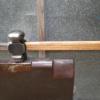
wpearson
-
Posts
240 -
Joined
-
Last visited
Content Type
Profiles
Forums
Articles
Gallery
Downloads
Events
Posts posted by wpearson
-
-
brianbrazealblacksmith
Posted 24 Dec 2012 · Report post
Cut a piece of 1 inch square tubing 2 3/4 inches long and weld it to a piece of metal that fits in your hardy hole, where the square tubing stands up straight on your anvil. Then get some coil spring that fits inside the square tubing snugly with a little slop so it will move up and down. Now cut a 3/8 inch long disc off the coil spring and chisel your stamp design into the disc. Drop it down the tubing where it rests on the anvil with your chiseled design up. Prepare a 3 inch long piece of the same coil spring to use as your stamp by cutting it to the center with a hot cut hardy on both ends. Leave the point on the end that will be your stamp and clean up any burrs if there are any. Dome the striking end. Heat up the pointed end, brush once, drop it down the tubing, hit it once with a sledge hammer, and then harden and temper the stamp end.
Lyle, Urnstbeast, and I came up with this in a class a few years ago and have made several with others over the years. You have one hit to do it in, so make it good, and make your design appropriate. Just look at other stamps and notice the depth and surface area contact.https://www.youtube.com/watch?v=_Fl6nMNoiok&list=ULkU3_U6JHGdg&index=4
-
-
-
ifi has a couple of retort designs that are pretty much smokeless.
-
10.1.3. Fixed carbon content
The fixed carbon content of charcoal ranges from a low of about 50% to a high or around 95%. Thus charcoal consists mainly of carbon. The carbon content is usually estimated as a "difference"; that is to say, all the other constituents are deducted from 100 as percentages and the remainder is assumed to be the % of "pure" or "fixed" carbon. The fixed carbon content is the most important constituent in metallurgy since it is the fixed carbon which is responsible for reducing the iron oxides of the iron ore to produce metal. But the industrial user must strike a balance between the friable nature of high fixed carbon charcoal and the greater strength of charcoal with a lower fixed carbon and higher volatile matter content to obtain optimum blast furnace operation.
but yes, some of the volitiles that may not be compleatly converted to carbon may be carsinegenic, so dont lick the charcoal.
-
I was wondering if cold rolled from the steel yard would work well???
hot rolled is cheaper
-
-
that's a stack of anvils hand or power
-
-
Antique 1899 Heavy Duty Shop built Blacksmith Forge Anvil - $475
-
Are those parting lings or flash from drop forging ?
-
look by the anchor bolts in lowes, hd ,or others.
-
forge is 10"x14"with legs across each end. Brick size: 4-1/2 in. W x 9 in. L x 1-1/2 in. H stack two bricks across each end under legs place one cookie sheet across bricks. stack two bricks on each end of cookie sheet. put forge on top of bricks.
-
-
just grout it flat
-
valve grinder
-
The paint mono mixed powder of coal and on the side in order to prevent oxidation.
-
Will you isolate it from the floor?
-
I am also trying to build a non-reciprocating single blow air hammer on a lark since that sounds cool!
Ernest.
Search KA75.
-
-
-
I read it as a 25kg carton
-
I have talked to Jymm Hoffman via email about his "slot burner" He claims that they will burn household pressure natural gas (using forced air of course) and weld in a propane tank type or smaller forge. I believe there is a thread here in this section albeit a fair piece back into the archives
Edit: Hmmmm maybe not. may be too old to come up in a search with normal parameters
Scott
Is this it
-
Please explain the difference in these two methods...
Nothing Ausfire agrees with Michael.



spark arrestor
in Welding/Fab General Discussion
Posted
forb